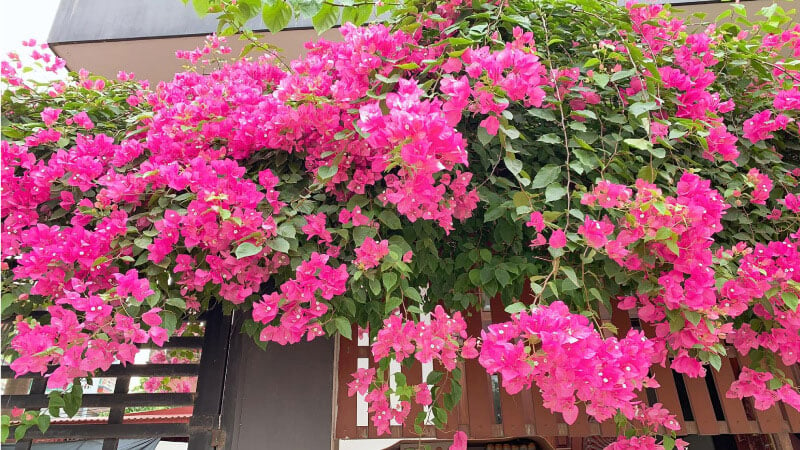As the weather turns colder, bougainvillea enthusiasts often worry about the plant’s ability to flower due to the significant decrease in sunlight. However, bougainvillea is a resilient plant that can bloom year-round with proper care. Even in winter, adequate lighting can promote growth and vibrant flowers.
A crucial factor to ensure blooming during winter and stable growth is nutrition. Regularly watering bougainvillea with soybean water will result in more abundant and beautiful blooms.
While the nutritional requirements of bougainvillea are not complicated, providing the right type of nutrients is vital for the plant’s health and robust flowering. Soybean water, acting as a natural organic fertilizer, efficiently meets the plant’s nutritional needs, especially during fall and winter.

Providing the correct nutrients is crucial for the plant’s health and vigorous flowering.
Instructions for Making Soybean Water for Bougainvillea Care
Start by preparing a quantity of dried soybeans. Soak them overnight to allow absorption and expansion. After they have softened, cook them until they are tender. Once the soybean water has cooled, pour it into a bottle and let it ferment for about two weeks.
The fermented soybean water can be directly used for watering bougainvillea. However, to avoid potential harm to the roots from un-decomposed organic compounds, dilute it before use. The ideal dilution ratio is one part soybean water to five parts clean water, ensuring the plant absorbs necessary nutrients without damaging the root system due to excessive nutrient concentration.
Compared to chemical fertilizers, soybean water has several advantages. Firstly, it is a natural organic fertilizer, free from harmful chemicals, thus protecting the environment and not negatively affecting bougainvillea growth.
Additionally, soybean water is rich in nitrogen, essential for plant growth. It also contains some phosphorus and potassium, vital for root development and flower bud formation. Using soybean water improves the plant’s health and enhances its blooming potential.

Using soybean water improves the plant’s health and enhances its blooming potential.
Guidelines for Using Soybean Water for Bougainvillea Care
Applying soybean water is an effective method for bougainvillea care. When watering, focus on the area around the base of the plant. This ensures that the nutrients in the soybean water penetrate deeply into the soil, reaching the roots and promoting their growth. For optimal results, water the bougainvillea with soybean water about once a month. With this regimen, you will notice an increase in flowering and more buds on the branches.
However, some essential points should be noted when using soybean water. Firstly, ensure the soybean water has fully fermented, as un-decomposed substances can harm the roots. Secondly, control the amount of water, using only a moderate amount to prevent “root burning,” which affects the plant’s health.
Additionally, soybean water has a limited shelf life. Therefore, it is advisable to use it immediately after mixing to ensure its effectiveness. Proper use of soybean water will result in healthy bougainvillea plants with vibrant blooms.

Proper use of soybean water results in healthy bougainvillea plants with vibrant blooms.
Important Considerations for Bougainvillea Care During Winter
Winter is a critical period for bougainvillea care, requiring special attention to maintain vibrant flowering. In addition to monthly soybean water treatments, use warm water for watering. This helps the plant withstand the cold and stay healthy.
Pruning also plays a vital role in winter care. Proper pruning not only reduces the plant’s nutrient consumption but also concentrates the nutrients in the main branches and shoots. This ensures the plant’s ability to grow and flower beautifully despite the cold weather.
Pay attention to removing weak or withered branches, as they can affect the plant’s ability to absorb nutrients and increase the risk of pests and diseases. Meticulous care during this season significantly contributes to the bougainvillea’s vitality and beauty in the colder months.
The Ultimate Guide to Rocking Shorts in Fall/Winter: A Fashionista’s Handbook to Chic and Cozy Style
“As the seasons transition from summer to fall and winter, you might think it’s time to pack away your beloved shorts. But hold on! With the right choices in fabric and style, coupled with clever layering, you can absolutely rock a pair of shorts all year round. It’s all about knowing how to pair them with other items in your wardrobe to create looks that are not only fashion-forward but also cozy and comfortable. So, get ready to give your favorite shorts a new lease of life and discover the endless styling possibilities they offer, even during the cooler months!”



































